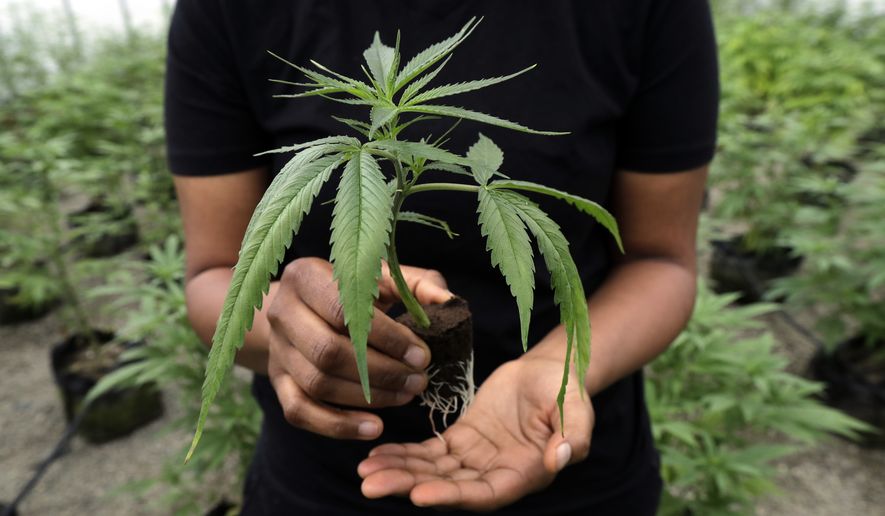How much pot is too much pot?
That’s a key question state law enforcement and health officials are trying to answer as they create guidelines on how to use marijuana and as the public increasingly embraces pot for medical and recreational purposes.
Complicating law enforcement efforts is that there is no handy device to measure quickly and accurately the amount of THC (the psychoactive compound in pot) in a person’s bloodstream. The Breathalyzer, which was developed in the 1950s, has long been used to measure a person’s blood alcohol content, but there is no similar device for marijuana.
What’s more, Colorado and Washington — the first two states to legalize recreational pot — have made it illegal to drive with 5 nanograms per milliliter (5 ng/mL) of THC in one’s blood, but it’s difficult to determine how that level impairs driving or could be detected in a roadside stop.
“By Colorado law, the only device you can use at a roadside stop is an alcohol detection device,” said Sam Cole, a spokesman for the Colorado Department of Transportation.
Other states have a zero-tolerance policy for any marijuana use while operating a vehicle.
Conversely, a blood alcohol content of .08 percent is the national standard for alcohol impairment.
Mr. Cole said that marijuana accounted for about 12 percent of DUI arrests in 2014, the year recreational pot became legal, in Colorado. About 19 percent of DUIs were pot-related in the following years, and today marijuana accounts for 15 percent of those arrests, he said.
“So that’s an indication, not necessarily that more people are driving high, but an indication that officers are better trained,” Mr. Cole said.
While law enforcement wrestles with the legal complications, health officials are trying to address the safety issues that arise in a pro-pot society.
The specific risks associated with marijuana use have long been a topic of debate. In November, the death of an 11-month-old boy in Colorado was widely reported as the first pediatric marijuana-related fatality. A case report published in a scholarly journal noted that the boy died of myocarditis, an inflammation of the heart, and marijuana was confirmed in his system.
But a co-author of the report, Dr. Thomas Nappe, later told The Washington Post that he and his colleague “are absolutely not saying that marijuana killed that child.” He said a cause-and-effect relationship between the marijuana and the boy’s death could be determined. Most cases of pediatric myocarditis result from a virus in the heart, but doctors could not confirm a viral infection as the cause.
Twenty-nine states and the District of Columbia allow medical marijuana. Nine states and the District also allow for the possession, use or sale of recreational marijuana. But the federal government still bans its manufacture, possession, distribution and use as a Schedule I drug — the same category as heroin, LSD and peyote.
Polling data indicate that 60 percent of the U.S. population favor legalization, and at least 12 states are considering medical or recreational laws.
Scientists stress that research in how legalization affects pot use is still preliminary, but among states with marijuana laws, the number of new users didn’t significantly increase. Those who already use marijuana, however, are likely to consume more of it and more often.
Health risks associated with heavy marijuana use include psychosis, dependence and accidents. For pregnant women, it can harm fetal development and poses risks in breast feeding. It also can cause developmental problems for children and teenagers.
How people consume marijuana also presents unique dangers.
Dabbing, in which concentrated forms of cannabis or hashish are heated and their vapor inhaled, has been shown to give off toxic chemicals.
The risks of smoking pot are not as well established as tobacco cigarettes — although scientists say it is similar or potentially more harmful. There’s little evidence to suggest that marijuana causes cancer, though.
Other concerns are increasing levels of THC, both in the plant itself and manufactured products like edibles. Research from the University of Mississippi found that among illicit marijuana, potency has increased by 10 percentage points over 10 years.
In Colorado, THC levels in some products range from 20 percent to 30 percent, and lawmakers are debating with manufacturers and the public over regulation.
In Vermont, which is preparing for legal sales to begin July 1, a committee tasked with education and prevention is looking at ways to regulate THC concentrations in marijuana products.
Public health campaigns for the drug often are likened to how regulation has treated alcohol and cigarette use, with the latter the most informative in balancing for-profit models and public safety.
Policies that help mitigate health risks include restricting age of access, limiting advertising and sales, creating a prevention fund for education from sales taxes and limiting the potency of products.
Advocates for legalization stress that education and awareness can help prevent accidents, minimize use and promote health and safety.
“The most effective tool for changing normative social behavior is not punishment, is instead really giving people accurate information about true harm and helping to prevent problematic behavior,” said Jolene Foreman, a staff attorney for the Drug Policy Alliance advocacy group.
The alliance is working in New Mexico, New Jersey and New York on policy ideas that would balance public demand for recreational marijuana and ensure safety. These states show how far the conversation has come from prohibition to legalization, Ms. Foreman said.
“Now we’ve had several states who have tested legalization and we’ve seen that the sky hasn’t fallen, legalization is working,” she said.
• Laura Kelly can be reached at lkelly@washingtontimes.com.




Please read our comment policy before commenting.